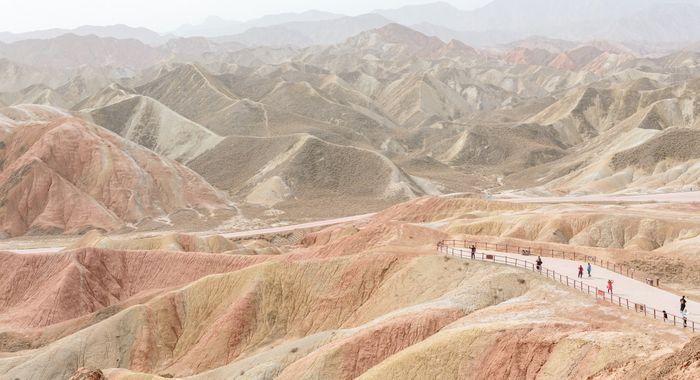Journalism // Destination Unknown (SUITCASE Magazine Vol. 28)
I arranged a trip with the high-end operator Brown+Hudson to road-test their "Journey With no Destination" concept, which aims to take the "where" out of travel and replace it with the "why" by organising itineraries in mystery destinations for clients, using an in-depth questionnaire as the basis for each trip. After taking the questionnaire and being analysed by a "travel psychologist" I was picked up from my flat and taken to the airport to embark on a trip to Lima, with details of the plans for each day only being provided each evening. Accompanied by the photographer Billy Bolton, what ensued was an eye-opening and creative reading of the city involving hip-hop dancing ballerinas, equestrian artists and flute-playing fisherwomen.
I bob up and down on the whipped, steely sea, clutching on to the side of a small fishing boat. In front of me a fisherwoman casts her colossal net from an even tinier vessel, drifting dangerously close to the craggy rocks along the shoreline where the water flings itself into desperate extinction. Suddenly she reaches inside her waders, pulls out a wooden flute and begins playing. As the piping floats along the breeze towards me, the effect is so bizarre, so eerie, that I feel more like the protagonist of a Freudian psychological vignette than your typical traveller.
Much of my time in Lima shares these smudged edges of a dream, smoothed and softened into a state of the surreal under the lick of a fog-shrouded sky. This impression is engendered not only by the chaos and magic of the city, but also by the fact that I had delivered myself into the hands of others to shape my journey and had no choice but to be carried along, much like a fishing boat in the flinty, serrated waves.
The dream-weavers were Brown + Hudson, an experientially minded travel company that specialises in crafting itineraries with a jolt of the unexpected. I had volunteered to embark on its “Journey with No Destination”, a concept engineered to take the emphasis off the “where” of travel and instead focus on the “why”. In our age of information, where the average holiday is precluded by a panicked scrabble through an endless scroll of tweets, Instagram posts and online guides, often resulting in a copy-and-paste assemblage of recommendations, Brown + Hudson reframes this approach by asking travellers to complete an in-depth questionnaire probing their motivations, personality traits and desires. Their answers are analysed by a “travel psychologist” to create an individual profile, which the Brown + Hudson team use as the basis to design a trip centred on personal transformation and growth, equal parts adventure and therapy.
Amid the salt-smell of the surf and the ghostly outline of spindly palms against the sea, I discover that tomorrow’s activities will focus on “giving back”, in accordance with my determined preference for orienting my travels towards others rather than myself. Our first stop will be visiting the D1 Cultural Association, a non-profit organisation run by ex-ballerina Vania Masias, a native Limeña who turned her back on the opportunity to participate in the Cirque du Soleil in order to teach local children street dance and leadership skills. There’s a kick, though – to challenge my self-professed fear of public speaking, I’ve been asked to give a few “inspirational words of encouragement” to the students.
Armed with a few pro tips on a printed sheet, we arrive the next morning at D1’s headquarters, where a few dancers are warming up. Vania tells me how, after studying in London, she returned to Lima at the age of 25 for a holiday and ended up never going back, having been struck by the sight of young men performing in the streets. She converted her family home into studios, brought over choreographers and slowly won the trust of her students, many of whom had left school before 15 and risked a life of violence. Today more than 100,000 children have been through the programme and 65 per cent of graduates are entrepreneurs. Vania is also working with the government to implement her methodology in schools across Peru, developing not only dance but also emotional skills and the value of working together. “In order to save the world, we need to build community,” she tells me.
It’s an impressive manifesto that leaves me feeling rather sheepish about any words of wisdom I might have to impart. Regardless, I muster my bravado and tell the assembled circle of students about my admiration for their tenacity and how as an editor, I appreciate the strengths and struggles of creating something in chorus. Before we leave, I’m made to join in with their warm-up, the combination of ambassadorial duties and robotic white-girl dancing meaning that for the first (and last) time in my life, I feel a true sense of kinship with Theresa May.
Like many South American cities I’ve visited, Lima has a fragmentary, chaotic temperament that lends it an unworldly air – not for nothing is it a running joke among the continent’s inhabitants that writers such as Gabriel García Marquez and Peru’s own Mario Vargas Llosa are named “magical realists” simply for writing about life as it is. A desert swathed for much of the year by an ominous grey mist locally known as the “donkey’s belly” in which giant buzzards swim like fish, it is a place where extremities thrive (dry and wet, rich and poor, ancient and modern) and storybook-like characters are likely to emerge from the murk at a moment’s notice. Nowhere is this more clearly underlined than when I find myself speeding past tumbledown towns and swamps filled with wild guinea pigs en route to the fishing village of Pucusana.
A far cry from the tourist trail, this ramshackle resort on the city’s outskirts is also a working market where fishermen draw up in their Lego-coloured boats to barter with buyers amid a frenzy of sloshing buckets of squid and rainbow stacks of crates. We’re here to meet Karin Abensur, the CEO of a sustainable seafood company that aims to improve the lives of artisanal fishermen by paying them a fair price, as well as providing a sustainable income to local women by giving them employment filleting the fish, which is then sold to Lima’s top restaurants.
Karin is a formidable force with a filthy laugh,a wicked sense of humour and a fierce passion for Peruvian artisanship that manifests not only in her commitment to traditional fishing, but also to the Peruvian flute. It’s this quirky combination that leads to an impromptu performance amid the waves before we’re treated to an encore of ceviche made fresh on her boat, the sea breeze the “extra ingredient” that gives it its piquancy.
In a final attempt to challenge my limits, a para-triking session above Lima’s coastline is planned for our last morning – however, the press of the fog means we have to cancel (admittedly, somewhat to my relief) and instead spend the hours wandering the streets of the historical centre, where a religious procession trails incense and confetti across the cobbles.
It’s a more conventional mode of exploration that reminds me just how much I’ve managed to penetrate Lima’s walls over the past few days. Having always believed that people give you the best insight into the character of a place, I realise that the theatrical cast assembled to tell me the story of their city has also told me something about myself and my way of seeing the world. Perhaps a psychological vignette was the aim all along.

